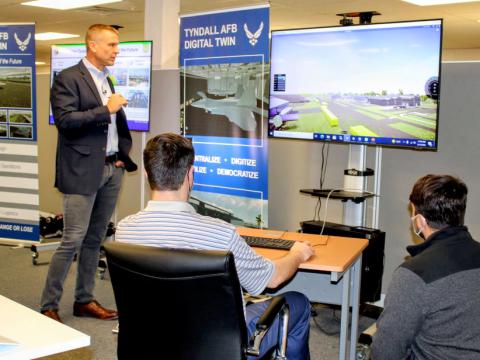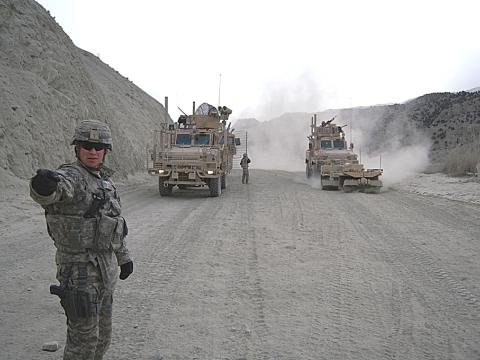Communications Company Focuses On Growth
Tactical Radio Supplier Adds New Defense Electronics Contracts 
Soldiers of the 82nd Airborne on patrol in Iraq are equipped with a Harris AN/PRC-152(C) radio. The company currently has a backlog of $1 billion
in orders for its tactical radios.
If Howard Lance ever decides to sell his 22-foot motorboat docked at his home on the Intracoastal Waterway in central
That’s because he is too busy to go boating. Lance has been building Harris Corporation into a $4.2 billion assured communications behemoth that has more than doubled in size since he became chairman, president and chief executive officer just five years ago.
A major supplier to the defense and intelligence communities, the company is based in
Nearly 40 percent of Harris’ 16,000 employees work in or near the headquarters. About 1,200 work in the
A native of
Though Harris is a far-flung corporation operating in 150 countries with complex technologies and many business units, Lance keeps his overarching business philosophy simple: constant innovation, filling in the franchise with new products and company acquisitions, and relentless execution of his business plans.
This he says explains why new products recently accounted for 35 percent of product revenues, more than double the 15 percent for that category roughly three and one-half years ago. Lance says he uses this statistic as a barometer of innovation at Harris, a feature he says will allow it to grow even as many analysts expect to see flat or declining military budgets.
Ranked as one of the nation’s top 25 federal prime contractors according to Washington Technology Journal, Harris designs, develops and maintains advanced communications networks and information systems for defense and intelligence organizations. The company also has key contracts with several civilian agencies.
Overall, domestic and international government sales account for about 75 percent of revenue with the rest coming from the commercial sector, Lance says. Of those federal contracts, defense accounts for roughly half and intelligence about one-fourth. Civilian agencies account for the remainder, he adds.
In June of last year, Harris announced one of the larger military contracts registered in 2007, a deal with the Navy valued at $2.7 billion to provide interim software-defined, single-channel handheld tactical radios. The contract will help consolidate handheld radio purchases across participating services to significantly reduce unit costs, the Pentagon says.
Defense officials added that the final value of the contract could be several times larger because the program includes options for four one-year extensions. Harris already has a $1 billion backlog of orders for its tactical radios and also uses these products as entries into new international markets.
Also in June 2007, Harris completed its $400 million cash acquisition of Multimax Incorporated, a privately held concern based in
“We haven’t provided any specific individual financial guidance beyond this year,” he notes. “But we have said to the market that we want to be able to have sustainable growth of at least 8 percent to 10 percent of organic growth in revenue, supplement that with some number of continued strategic acquisitions—and we certainly want to be able to have long-term earnings growth at our target level of 15 percent per year.
“I see no reason that those kinds of growth rates are not sustainable. We get lots of questions, and one that might be on your mind is, ‘Well, you know government spending is going to slow down, defense spending is going to slow down, peace is going to break out in the world as a result of the next administration, so that means things are going to be a lot softer for your company, right?’
“And our view is, ‘Listen, the government markets that we serve and the commercial markets frankly are sufficiently large to support sustainable growth at Harris. We don’t need to have our markets grow 10 percent to 15 percent in order for us to grow at that rate. These markets are very large.’ So for us, it’s more about, ‘Do we have the new technologies and innovations to win new government programs?’
“I think growth is a mindset, and any executive at Harris would tell you that it’s been our mindset and our passion for the past several years. We realize that to continue to create shareholder value, to continue to perform at above our peer group companies—we don’t want to just be one of the pack—you really have to set very high goals for yourself. And you have to be willing to move into areas that are not just those that are your legacy areas.”
Consider the
Last year, Harris conducted census field trials in advance of the 2010 national headcount using 1,400 of the company’s handheld computers. The devices feature global positioning system (GPS) technology and biometric security to capture canvassing information directly. Designed to save taxpayers approximately $1 billion, the program ranks as the largest mobile computing initiative ever, according to Harris officials.
That program has not been trouble-free. Recent reports have indicated that Congress is worried about it running over budget. Government officials have expressed concerns that delays might leave the technology not ready for the 2010 census. A Government Accountability Office audit noted that some of the overrun came from Census Bureau officials adding requirements to the system during its development.
In a separate statement, Harris officials say that it is not unusual for a program of this size and length to encounter some challenges and customer requests for additional requirements. They add that to date the company is successfully executing to the current set of requirements, and it is working with the Census Bureau to get a final set of requirements.
The Federal Aviation Administration (FAA) remains another major Harris customer. The company is the prime contractor and system architect for the FAA Telecommunications Infrastructure, which Harris officials say is one of the larger government telecommunications initiatives undertaken to date.
The network ensures the efficient, secure and reliable transmission of voice, data, radar and weather, and other critical information. It replaces six legacy networks with one nationwide, all-digital network backbone at more than 4,000 FAA facilities. Harris estimates taxpayer savings of $600 million over the program’s 15-year lifespan.
“Five years ago, we had about $30 million or $40 million in technical services contracts and revenue per year,” Lance explains. “Today, that number is closer to $800 million of technical services contracts per year that we have with defense, intelligence and federal agencies. So, again, that’s another example of how we have diversified and driven the business and the growth of the business in new areas.
“You know, my job is all about working with the Harris team to identify those markets that show promise for the future, to make investments in technologies and capabilities, to innovate so that we have a reason for those customers to want to pick us and then to execute on those programs or the products,” he emphasizes.
In late January, Harris reported revenue for its second quarter of fiscal year 2008 of $1.3 billion, an increase of 30 percent compared to $1 billion for the similar period a year ago. Organic revenue, which excludes the impact of acquisitions, increased 13 percent compared to the prior-year quarter.
The company also said its Defense Communications and Electronics segment registered revenue of $472 million, an increase of 18 percent compared to the prior-year quarter.
Though he likes to play tennis and golf, Lance has little time to pursue those interests. Associates say he does enjoy playing jazz on a
Lance shares that when he isn’t focused on Harris’ double-digit growth rate, he and his wife spend much of their available time helping charitable groups and universities in central
“We have a pretty busy life between our children, our business and the not-for-profit things we do,” observes Lance, a Presbyterian who says faith plays an important role in his life. “But that’s the way we like it. We’re both very much kind of Type A personalities, results-oriented, and we’re old-fashioned.
“We believe you are put on this earth to try and make a difference in lots of ways and in the lives of lots of people. So, we do our best to try and do that and be true to that kind of value.”
Not that he hasn’t received accolades for his day job. Consider that also in 2006 the American Business Awards, a national organization that bestows an Oscar-like “Stevie” on winners, named Lance the country’s Best Chairman. In 2005, The American Electronics Association of Florida named him its Technology Executive of the Year. He strives to continue to meet the standards that those awards represent.
“I believe philosophically, and our organization certainly concurs, that it is all about continuing to raise the bar every year, every quarter, to try and create value for our shareholders,” Lance concludes. “To do that, we’ve got to continue to innovate; we’ve got to continue to come up with new solutions to solve the emerging customer problems.
“So, I certainly don’t feel we’ve hit a high water mark at all. I think we are just getting into our stride. Major strategic change in a company doesn’t occur overnight. It takes multiple years to implement, and so I very much feel like we’re still on the journey. We had a great five years, but there are a lot of things we put in place over the last few years that I think bode well for the future.”
Web Resource
Harris Corporation: www.harris.com


